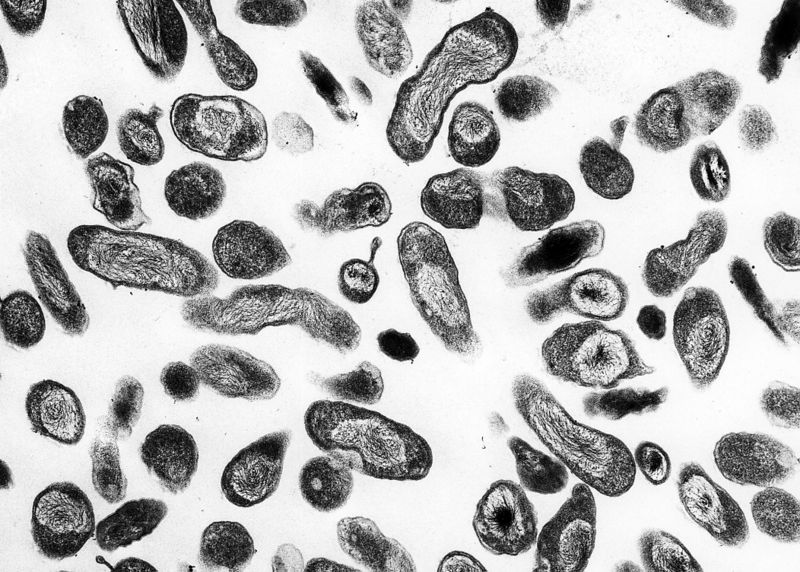Sandbox: q old
 |
- Cattle, sheep, and goats are the primary reservoirs of C. burnetii. The infection has been noted in a wide variety of other animals, including other species of livestock and in domesticated pets.
- Coxiella burnetii does not usually cause clinical disease in these animals, although abortion in goats and sheep has been linked to C. burnetii infection.
- Organisms are excreted in milk, urine, and feces of infected animals. Most importantly, during birthing, the organisms are shed in high numbers within the amniotic fluids and the placenta.
- The organisms are resistant to heat, drying, and many common disinfectants. These features enable the bacteria to survive for long periods in the environment.
- Infection of humans usually occurs by inhalation of these organisms from the air that contains airborne barnyard dust contaminated by dried placental material, birth fluids, and excreta of infected herd animals.
- Humans are often very susceptible to the disease, and very few organisms may be required to cause infection. Ingestion of contaminated milk, followed by regurgitation and inspiration of the contaminated food, is a less common mode of transmission.
- Other modes of transmission to humans, including tick bites and human to human transmission, are rare.
History and Symptoms
- Incubation period is usually 2 to 3 weeks.
- The most common manifestation is flu-like symptoms with abrupt onset of:
- During the course, the disease can progress to an atypical pneumonia, which can result in a life threatening acute respiratory distress syndrome (ARDS), whereby such symptoms usually occur during the first 4-5 days of infection.
- Less often the Q fever causes (granulomatous) hepatitis which becomes symptomatic with:
- The chronic form of the Q fever is virtually identical with endocarditis, which can occur after months or decades following the infection. It is usually deadly if untreated. However, with appropriate treatment this lethality is around 10%
Only about one-half of all people infected with C. burnetii show signs of clinical illness. Most acute cases of Q fever begin with sudden onset of one or more of the following: high fevers (up to 104-105° F), severe headache, general malaise, myalgia, confusion, sore throat, chills, sweats, non-productive cough, nausea, vomiting, diarrhea, abdominal pain, and chest pain. Fever usually lasts for 1 to 2 weeks. Weight loss can occur and persist for some time. Thirty to fifty percent of patients with a symptomatic infection will develop pneumonia. Additionally, a majority of patients have abnormal results on liver function tests and some will develop hepatitis. In general, most patients will recover to good health within several months without any treatment. Only 1%-2% of people with acute Q fever die of the disease.
Chronic Q fever, characterized by infection that persists for more than 6 months is uncommon but is a much more serious disease. Patients who have had acute Q fever may develop the chronic form as soon as 1 year or as long as 20 years after initial infectioQ-fever can cause endocarditis (infection of the heart valves) which may require transoesophageal echocardiography to diagnose. Most patients who develop chronic Q fever have pre-existing valvular heart disease or have a history of vascular graft. Transplant recipients, patients with cancer, and those with chronic kidney disease are also at risk of developing chronic Q fever. As many as 65% of persons with chronic Q fever may die of the disease. Q-fever hepatitis manifests as an elevation of ALT and AST, but a definitive diagnosis is only possible on liver biopsy which shows the characteristic fibrin ring granulomas.[1]
The incubation period for Q fever varies depending on the number of organisms that initially infect the patient. Infection with greater numbers of organisms will result in shorter incubation periods. Most patients become ill within 2-3 weeks after exposure. Those who recover fully from infection may possess lifelong immunity against re-infection.
Common symptoms include:
- Dry cough (nonproductive)
- Fever
- Headache
- Joint pain (arthralgia)
- Muscle pains
Other symptoms that may develop include:
- Abdominal pain
- Chest pain
- Jaundice
- Rash
Complications
Rarely, a heart infection results that can lead to severe symptoms or even death if untreated. Other complications can include:
- ↑ van de Veerdonk FL, Schneeberger PM. (2006). "Patient with fever and diarrea". Clin Infect Dis. 42: 1051&ndash, 2.